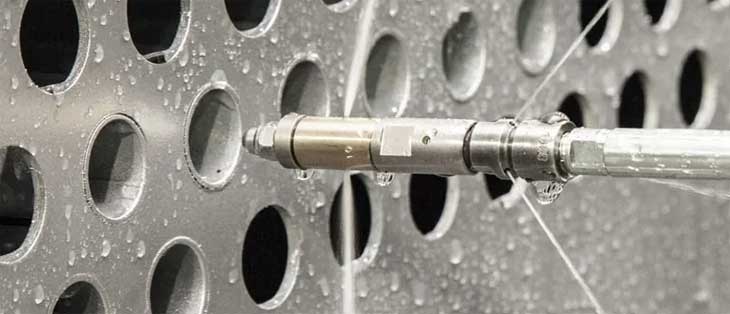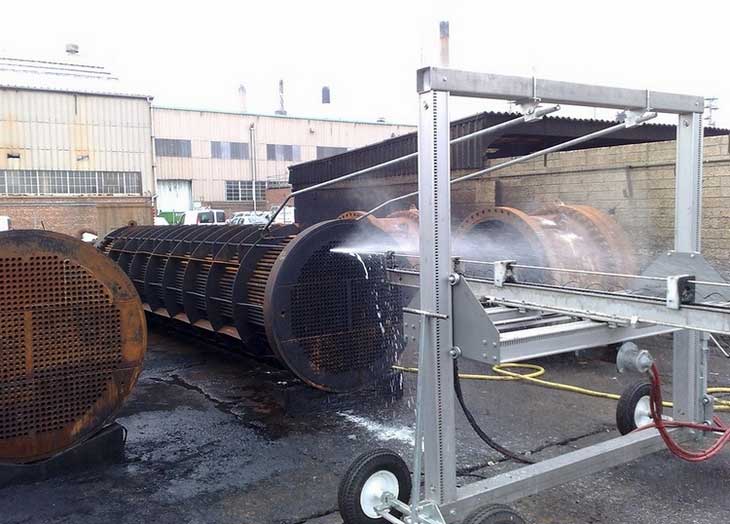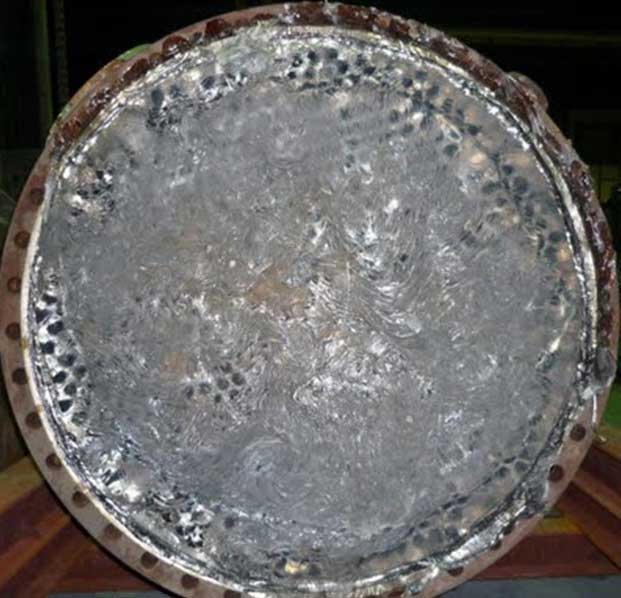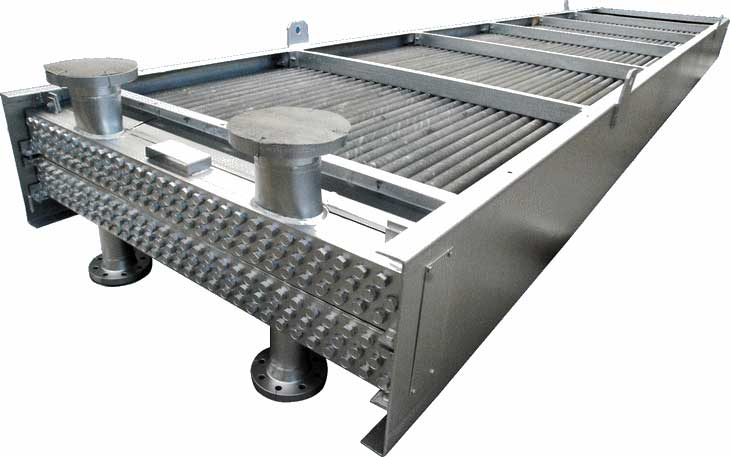 |
Cleaning of Shell and Tube Heat Exchangers |
Clean heat exchanger tubes are essential to the functionality of shell and tube heat exchangers. When they become fouled, the result can be a decrease in the efficiency of the entire unit.
This affects flow rate, heat transfer and fluid pressure. Regular cleaning and maintenance ensures smooth process flow for system operation.
While the need to clean heat exchanger tubes is an established fact, there are several methods of doing so.
High-Pressure Water Blasting
The traditional method for cleaning exchanger tubes is high pressure water jetting. The water is propelled from a nozzle at an extremely high pressure up to 2500bar (36000psi), blowing away dirt and debris.
The internal cleaning of heat exchangers under high pressure is carried out with flexible hoses or with stainless steel lances. In the past the cleaning was often done with 1 lance where for example, 1000 tubes had to be cleaned. This lance was handled by one operator, without any support. Considerable safety risks were often not guaranteed.
Nowadays, so-called Tube Lance Equipment (TLE) are used, on which the lance is mounted. Multiple lances can be mounted on these TLE's, and in almost all cases, they can be controlled from a safe distance.
 Turbojet
nozzle (Image: hogedruk.koks.com)
Turbojet
nozzle (Image: hogedruk.koks.com) The problem with high-pressure water jetting is that it is slower than other competing processes. The speed of the process is slower because lances are pushed down and back along the entire length of the tube. The operation of the lances extends the cleaning time compared to other cleaning systems.
In addition, operators face hazards from the water blast itself, even with the remotely controlled systems. Also, high-pressure water jets use larger amounts of water than competing systems. Recycling/disposal of this cleaning water adds to the overall cost of the project.
 HP
Water Blasting (Image: www.bvmindustries.co.in)
HP
Water Blasting (Image: www.bvmindustries.co.in)
Mechanical tube cleaning
Today's industry places great importance on protecting the health and well-being of both its employees and the environment. Managers in chemical plants and refineries have been asked to find better and safer ways to clean their heat exchangers while minimizing the impact of wastewater.
An emerging trend in keeping heat exchangers clean is the use of mechanical pipe cleaners. These mechanical systems use a variety of shooting, brushing and drilling methods combined with low pressure water below 48 bar (700 PSI). These methods work safely and quickly to remove even the most hard-to-clean deposits.
As an alternative to current practices, these mechanical pipe cleaning systems offer a much smaller footprint than traditional high-pressure water methods, and allow the equipment to be located much closer to the heat exchanger which further reduces congestion during overhaul.
By using less water and pressure, these mechanical pipe cleaning systems are much safer to use and generate much less wastewater than high-pressure water methods. Mechanical cleaning technology has proven to be safe, effective and environmentally friendly.
The video below shows various mechanical methods for cleaning heat exchanger tubes.
Mechanical tube cleaning
Chemical cleaning
Chemical cleaning of the heat exchanger is a kind of chemical change caused by a chemical cleaning fluid, which can decompose, remove or eliminate the scale and other deposits on the surface of the heat exchanger.
Chemical cleaning does not require disassembly and assembly of heat exchangers, which simplifies the whole cleaning process and eases the labor level for cleaning. The disadvantage is that if a poor chemical cleaning solution is chosen, the growing substrate from which the raw material is removed will be affected and cause damage.
Ultrasonic cleaning
It mainly uses ultrasonic sound field to deal with fluid mechanics, so that the shell-forming substance of fluid mechanics will cause a series of changes in its physical shape and chemical properties under the action of ultrasonic field, so that it will be dispersed, crushed and loosened.
Industrial Ultrasonic Cleaning
Thermal cleaning
Cleaning of heat exchangers polluted with (partly) organic contaminations like cokes, plastic, oil, paint, rubber, food etc. still is a major problem for many companies.
The need of parts’ cleaning is found in each and every industrial branch. Some take it as a daily necessity; others consider it an incidental procedure in times of calamity, turnaround or shutdown.
Apparently it is just part of the game, but nevertheless it should be done as quickly as possible and as best one can. In most cases this is very often related to the available knowledge of the known cleaning techniques.
 Heat
exchanger soiled with plastics
Heat
exchanger soiled with plastics As a result of the ever increasing quality of final products, the search for longer running times, the need for better cleaning results and cutting down costs or due to more stringent environmental laws and procedures, most of the traditional methods of cleaning, like chemical or high-pressure cleaning, are sometimes no longer adequate.
Maybe the thermal cleaning method can offer the desired solution for your cleaning problem?
Related Post(s)

The article discusses the dry and wet online cleaning process specially adapted for induced and forced air-cooled heat exchangers...